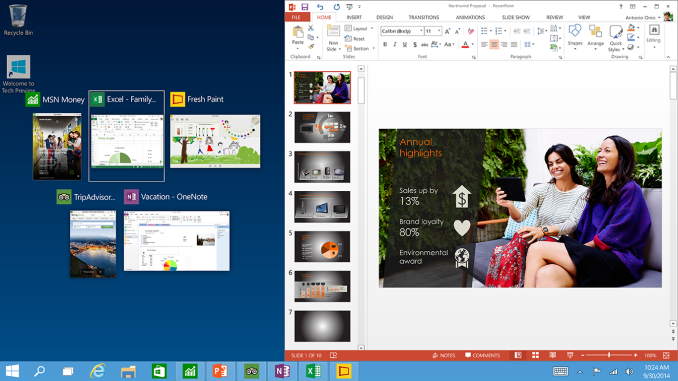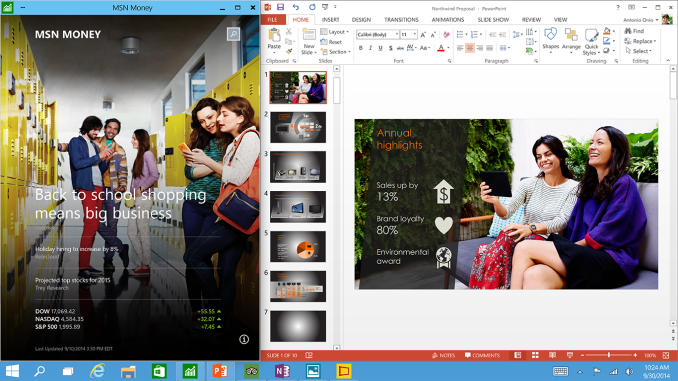Windows 10 Technical Preview First Impressions: The Return Of The Desktop
by Brett Howse on November 13, 2014 8:00 AM EST- Posted in
- Software
- Microsoft
- Windows 10
Closing Thoughts
If Windows 8 was “Touch First” then clearly Windows 10 is not. The current technical preview is very much geared towards the traditional mouse and keyboard user. This will change of course over the next several months, as the touch features get integrated back into Windows 10. As a user of all types of Windows devices, I welcome this change. It allows me to be more productive on my desktop, but still use the touch based Start Screen on a tablet or convertible notebook. Some good things have been done here to hopefully embrace the current user base, as well as new device types.
There are a number of features aimed squarely at businesses. If Microsoft wants to avoid another Windows XP with Windows 7 – where businesses do not migrate until they absolutely have to – then these features are certainly a carrot that may entice them to at least try it out. The Start Menu and other desktop additions will be great for the business users, and I think the IT crowd will be happy with a lot of the new additions around device management, identity management, and information management.
This is a technical preview of course, but still I would be remiss to not mention that it is not without its bugs. I have had a lot of issues with Windows Store apps, with many of them crashing especially when they are not the active window. Possibly there are some changes to the underlying WinRT framework for apps in standby but until we hear more about the framework changes then these problems will likely continue. More of this information should come out around the time of the next BUILD conference, scheduled for April 29th to May 1st 2015. Other issues with WinRT apps currently is that even though they can be used in a window, the absolute height of the window is limited. When Windows 8 was launched, WinRT apps were expecting to be either full screen, or snapped to the side. As such, the apps in a window must maintain a minimum height. Hopefully this can get sorted out in the future.
At first glance, Windows 10 looks like Windows 8 with a Start Menu. It is clearly a lot more than that, but even so, as someone very smart told me, that’s not a bad thing. Windows 8 had a lot going for it, but design decisions were made early on, and with a “my way or no way” attitude that it was difficult to use. It seems that Windows 10 really addresses a lot of this, while at the same time keeping and expanding on a lot of the great features that were in Windows 8 and likely overlooked due to a lot of animosity towards it.
The Windows Store is going to be a big part of this, and if the rumors of desktop apps being integrated into the store is true, then the OOBE for Windows 10 will be amazing. All of your settings and apps will now follow you from device to device, with a single log in. A lot of that is already there with Windows 8, but 10 should finish off the last remaining pieces if this is true. It makes a lot of sense, so unless the licensing terms are awful, this could be a fantastic addition to the store.
The Universal App model is also a big piece of the puzzle, but here there is more work to do. WinRT has a lot of advantages, but the framework needs to be updated at a rapid pace in order to draw developers in. It is somewhat seductive to be able to target desktops, laptops, tablets, phones, and the TV with Xbox One with a single application (with multiple interfaces of course) but until the framework is made powerful enough for more apps than just simple web front ends, it may be difficult to realize this idea. Once again, more info should be available at BUILD in regards to this.
I’ve also had some bugginess with the WinRT apps on Windows 8, which I hope will be fixed with Windows 10. At this point though, the WinRT apps are even buggier so likely there will be more pain before this is all corrected.
Although we have only seen the Technical Preview and a single update to it so far, you can see the potential for Windows 10 and what it will be able to accomplish. It is an ambitious goal to provide a single platform across such a swath of different devices, and one that was held back by the user interface before. With Continuum, it appears that it may be the best of both worlds. Even more exciting is how much more upfront and open Microsoft has been on this entire process, with not just the technical preview but also soliciting and requesting user feedback on the changes. One of the biggest change requests was a simple animation on the Start Menu, and that has already been implemented, so this really is a different world than when Windows 8 was given a sneak peek.
Due to the timing of the latest release that just came out, this article is based on the second build of Windows 10 and I have not had a chance to go over any of the changes in the latest built that arrived on November 12th.
Going forward, as we get more updates to the preview we will do our best to keep you fully informed with that the changes are, and how they will affect you. If you want to kick the tires of Windows 10 and you have not yet, just visit http://preview.windows.com and sign up for the technical preview.












198 Comments
View All Comments
Spawne32 - Thursday, November 13, 2014 - link
If you think Windows 10 will be free, you are wrong, they have already announced that Windows 10 will NOT be free, they will offer discounted upgrade paths for windows 7 and windows 8/8.1 users, but never in the history of Microsoft has windows ever been offered as a "free upgrade".jt122333221 - Thursday, November 13, 2014 - link
While this is more a "sp1" upgrade, Windows 8.1 was free and changed the name of the OS version (instead of appending SP1 or SP2 to the name). I would consider that as a new version for free.Spawne32 - Thursday, November 13, 2014 - link
Windows 8.1 wasn't a new version, it was a patch to solve the doomed sales of Windows 8 itself because of how unusable it was.Gigaplex - Friday, November 14, 2014 - link
It didn't install cleanly as a patch, it was built as a new version.snajk138 - Sunday, November 16, 2014 - link
And how is that different from Windows 10?anthill - Thursday, November 13, 2014 - link
DirectX 12 support will push me to upgrade if 7 doesn't support it.zepi - Friday, November 14, 2014 - link
January 14, 2020That is the day when Windows 7 runs out of extended support and that is the date you should seriously consider upgrading even if you don't like the options available...
rangerdavid - Friday, November 14, 2014 - link
Exactly. Brilliant.designgears - Saturday, November 15, 2014 - link
The speed of windows 8 and 8.1 alone is worth the $100.Lerianis - Sunday, November 30, 2014 - link
Or they are going to have to give a free upgrade to Windows 10 for people to justify it. Seriously, I never understood the "You have to keep paying to upgrade Windows!" nonsense. Just allow us to buy the operating system ONCE and our key, OEM or Retail, works for ALL future versions of Windows.Microsoft does not make most of their money on upgrades.... they make it on original sales of machines.